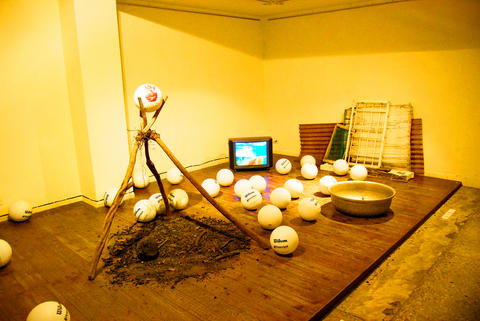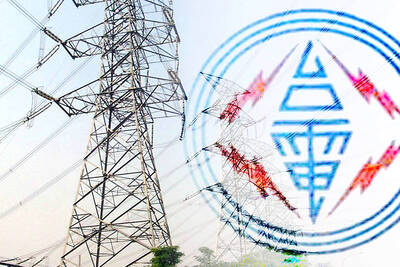It's the end of the year and the Taipei Times looks back at some great art moments and peers into its crystal ball to predict five up-and-coming artists/trends to watch out for. In keeping with the festive season, we'll count down like it's New Year's Eve:
5. Tseng Yu-chin (曾御欽) had his video work displayed at Germany's prestigious Documenta exhibition this summer. What was noteworthy was that he was not filling any quotas or participating in a national presentation. Rather he was included because he's an exceptional artist ready to participate at an international level. He recently embarked on a six-month art residency in New York.
4. Sean Hu Chao-sheng (胡朝聖). Okay, he's not an artist. He's a curator. His first experience was with land art and he's curated some notable exhibitions this year such as Lin Chuan-Chu's (林銓居) rice field/painting studio in Dazhi, Fashion Accidentally at Taipei MOCA and Very Fun Park in Taipei's East District (東區). What is remarkable about Hu's curatorship is his inclusiveness. He does not only invite ethnic Taiwanese for his exhibitions, which most Taiwanese curators tend to do, he includes artists and designers from various ethnicities, gender identifications and art practices to participate. Other curators, should take note.

PHOTO: SUSAN KENDZULAK
3. One of the best works created this year was by Yao Jui-chung (姚瑞中). Yao is no novice as he's already exhibited at the Venice Biennale, plus numerous other exhibitions. He's also known for curating shows and having authored several books. But the video he made where he's slowly goose-stepping about the CKS Statue Park in Tashi (大溪) Township, Taoyuan County, hits the bull's-eye. In this age of "desinicization," Yao's mockery of statues and idols is timely, comical and a tad visionary.
2. Number two is not an artist, nor a curator, but rather the notable status of the equality of women in Taiwan's art institutions: Lin Mun-lee (林曼麗) is director of the National Palace Museum; Lai Hsiang-ling (賴香伶) is coming to the end of her two-year contract with Taipei MOCA; Hsieh Hsiou-yun (謝小韞) is director of the Taipei Fine Arts Museum and Ava Hsueh (薛保瑕) is director of the National Taiwan Museum in Taichung.
1. Hands down! Our big winner for the year, undoubtedly, is Kuo I-chen (郭奕臣). Kuo seamlessly merges high-tech gadgetry with profound metaphysical concerns making him stand apart in Taiwan's contemporary art scene. He got off to a running start by first exhibiting at 2004's Taipei Biennial, when he was just a student, well, a grad student. This summer his participation in Thermocline: New Asian Waves at ZKM in Karlsruhe, Germany, brought him acclaim. The Centre Pompidou has bought his work for its collection. In October, he had four simultaneous exhibitions that featured work showing a destroyed earth but which demonstrated humanity's hope for survival. Meanwhile, international curators are flocking to his studio. The art world will have to wait, however, as Kuo just started his military service.

That US assistance was a model for Taiwan’s spectacular development success was early recognized by policymakers and analysts. In a report to the US Congress for the fiscal year 1962, former President John F. Kennedy noted Taiwan’s “rapid economic growth,” was “producing a substantial net gain in living.” Kennedy had a stake in Taiwan’s achievements and the US’ official development assistance (ODA) in general: In September 1961, his entreaty to make the 1960s a “decade of development,” and an accompanying proposal for dedicated legislation to this end, had been formalized by congressional passage of the Foreign Assistance Act. Two

March 31 to April 6 On May 13, 1950, National Taiwan University Hospital otolaryngologist Su You-peng (蘇友鵬) was summoned to the director’s office. He thought someone had complained about him practicing the violin at night, but when he entered the room, he knew something was terribly wrong. He saw several burly men who appeared to be government secret agents, and three other resident doctors: internist Hsu Chiang (許強), dermatologist Hu Pao-chen (胡寶珍) and ophthalmologist Hu Hsin-lin (胡鑫麟). They were handcuffed, herded onto two jeeps and taken to the Secrecy Bureau (保密局) for questioning. Su was still in his doctor’s robes at

Last week the Democratic Progressive Party (DPP) said that the budget cuts voted for by the China-aligned parties in the legislature, are intended to force the DPP to hike electricity rates. The public would then blame it for the rate hike. It’s fairly clear that the first part of that is correct. Slashing the budget of state-run Taiwan Power Co (Taipower, 台電) is a move intended to cause discontent with the DPP when electricity rates go up. Taipower’s debt, NT$422.9 billion (US$12.78 billion), is one of the numerous permanent crises created by the nation’s construction-industrial state and the developmentalist mentality it

Experts say that the devastating earthquake in Myanmar on Friday was likely the strongest to hit the country in decades, with disaster modeling suggesting thousands could be dead. Automatic assessments from the US Geological Survey (USGS) said the shallow 7.7-magnitude quake northwest of the central Myanmar city of Sagaing triggered a red alert for shaking-related fatalities and economic losses. “High casualties and extensive damage are probable and the disaster is likely widespread,” it said, locating the epicentre near the central Myanmar city of Mandalay, home to more than a million people. Myanmar’s ruling junta said on Saturday morning that the number killed had